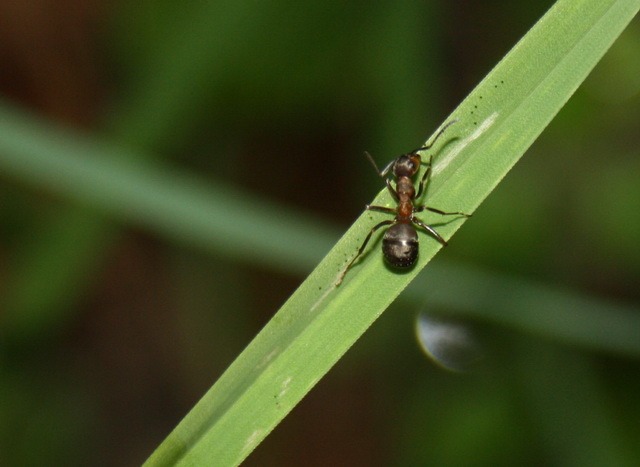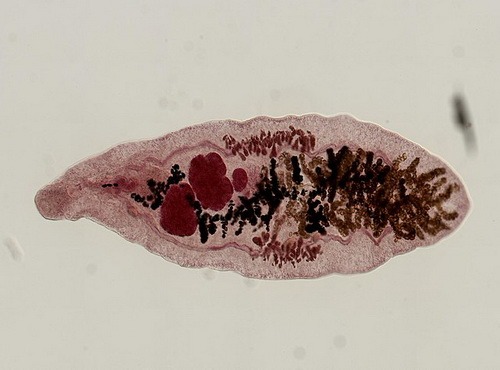Lancet liver fluke turns ant into zombie, but not during the day

Larvae of the lancet liver fluke, a parasite, have to transfer from ant to deer. They manipulate the behaviour of infected ants to maximize the chance of transmission, Simone Nordstrand Gasque and Brian Fredensborg report.
An ant carrying lancet liver fluke larvae is no longer itself. At the parasite’s command, it climbs up in the grass and stays there motionless. This makes it more probable for the parasite to reach the host in which it matures, a grazer. The manipulation is complex, as Simone Nordstrand Gasque and Brian Fredensborg show: an infected ant only remains high up in the vegetation when it is chilly; when it is warm, it comes back and behaves normally.
The lancet liver fluke (Dicrocoelium dendriticum, a flatworm) has a complicated life cycle with three larval stages in three different hosts; it cannot live outside a host. It develops successively in a land snail, an ant, and a grazing mammal, such as a deer, sheep, or a cow. So, it has to transfer several times.
Bile ducts
Adult liver flukes live in bile ducts in the livers of grazers. They mate and produce eggs that are excreted with the feces. The eggs are picked up by a land snail that nibbles on the droppings. The eggs hatch in the snail’s body into so-called miracidium larvae. They multiply asexually and thousands of larvae of the next stage, the cercaria larvae, appear. They migrate to the snail’s lung where they are packed in slime balls.
The snail coughs up the slime balls, and then it is the turn of the next host, which also comes by itself: the slime balls are tasty snacks for ants, which take them with them to their nest. Adult ants and larvae consume the balls and become infected. In ants, the cercaria larvae develop into the next stage, the metacercaria larvae.
Sacrifice
Now comes the most difficult transmission, which is necessary to complete the cycle: from ant back to grazer. That doesn’t happen easily. Ants reside in their nest or walk around on the ground. A grazer does not take a bite of that. The cycle could stop here, but now the parasite intervenes.
The larvae – there may be hundreds of them –safely encapsulate in the ant’s abdomen. But one of them moves to a ganglion in the ant’s head. It is unclear exactly how it manages, but this larva gains control over the ant’s behaviour. Like a zombie, the ant climbs up a blade of grass for no reason and locks its jaws to the vegetation. And so, a grazer may ingest the ant with the larvae on board along with the grass.
The larva that enabled the transfer dies in the grazer’s stomach. It sacrificed itself for the others, which emerge from their capsule in a safe place, develop into adult worms and settle in the bile ducts of the grazer: the circle is complete.
It is extraordinary that a parasite changes the behaviour of its host so drastically. But the lancet liver fluke does even more: it makes sure that the change is only expressed when it makes sense.
Sophisticated
Gasque and Fredensborg conducted research into the behaviour of the European red wood ant (Formica polyctena) after infection with lancet liver fluke in woods in Denmark, where roe deer live. They show that an infected ant only stays high up in the vegetation when it is cool, i.e., early in the morning and in the evening. During the day, it unlocks its jaws, goes down and behaves like the other ants.
It turns out that the temperature determines whether an infected ant is itself or becomes a zombie. Time of day, humidity and amount of sunlight do not matter. The warmer it is, the fewer infected ants persist in their biting behaviour. Only on chilly days at the end of the season, do many infected ants stay attached to vegetation all day.
This is beneficial from the parasite’s point of view. Because on hot days an exposed ant could overheat and die, and then the parasitic larvae would not survive either. Since deer mainly graze at dusk, there is no point in taking that risk. It is better to release the ant and let it ant behave normally, and only send it back up again in the evening.
Willy van Strien
Photos:
Large: infected European red wood ant, Formica polyctena. ©Simone Nordstrand Gasque
Smal: lancet liver fluke (Dicrocoelium dendriticum), adult. D. Drew (Wikimedia Commons, Public Domain)
Source:
Gasque, S.N. & B.L. Fredensborg, 2023. Expression of trematode-induced zombie-ant behavior is strongly associated with temperature. Behavioral Ecology, online 24 August. Doi: 10.1093/beheco/arad064
